TOWN HALL, VAS KONSTANTINOU 34 Tel – 2752023332
TOURIST INFORMATION, 25 MARTIOY Tel – 2752024444
POLICE, KOUNTOURIOTI 2 Tel – 100
TOURIST POLICE, KOUNTOURIOTI Tel – 2752028131
FIRE BRIGADE, 25 MARTIOU Tel – 2752027222
PORT AUTHORITY, KOTSONOPOULOU 5 Tel – 2752027022
CUSTOMS HOUSE, BOUBOULINAS 85 Tel – 2752027401
POST OFFICE, SIDIRAS MERARXIAS 1 Tel – 2752024230
TELECOMUNICATION HOUSE, POLIZOIDOU 2 Tel – 2752022121
HOSPITAL, KOLOKOTRONI & ASKLIPIOU Tel – 2752027309
BUS STATION, SIGGROU 8 Tel – 2752027323
RAILWAY STATION, PARALIAKI ODOS N.KIOY Tel – 2752026400
TAXI, SIGGROU 6 Tel – 2752024120
CARS HELP, ARGOS Tel – 104
LOCATION
Amymone is located in the old town of Nafplion, 50 meters from the beach and the parking.
NAFPLIO
Nafplio became the first capital of the new Greece
NAFPLIO
For those you who have not come back to Nafplio there are many interesting neighboring areas definitely worth visiting.
SIGHTSEEINGS
You can find in Nafplio...
Akronafplia
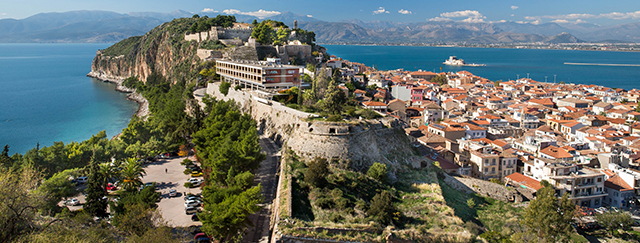 AKRONAFPLIA
AKRONAFPLIA
The rocky peninsula of Akronafplia was the walled town of Nafplion from antiquity to the late 15th century. Built on the feet of Palamidi, communicating along with a secret passage which is built on three different levels, each of which was a special castle. It is built on the ruins of the citadel testified by Pausanias. The Venetians extended the fortification they found, and reinforced the defensive with five cannons, named five siblings. When the Turks conquered Akronafplia repaired the fortifications and used Akronafplia as an outpost. Today only a few buildings such as the ruins of the castle of ancient Greek Acropolis and later Roman and Byzantine additions, are saved.
PSAROMACHALAS
The neighbourhood called Psaromahalas, the district of the fishermen are among the oldest and most picturesque neighborhoods and extends to the foothills of northwest Akronafplia above the street Staikopoulou. Today, Psaromachalas is one of the most picturesque spots of the old town of Nafplion. One going up the streetstairs, meet houses of various eras, some refurbished and others in ruins, while from the highest road one can see parts of the walls of Akronafplia. In todays square of Psaromachalas, there was a very important hospital destined for the poor, the first founded in Greece, a legacy of Florentine Duke of Athens Neriou Atsagioli. The hospital had long operation, with short breaks, from 1394 until the late 1940’s, when it was demolished. The only trace of this important hospital is the church of Holy Apostles, which was built by the Venetians and was originally located within the precinct of the hospital.
Lion of Bavaria
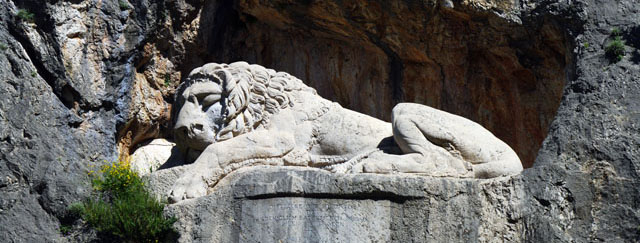 Among the church of Agion Panton and the current cemetery of the city, one finds in Michael Iatrou Street, an exquisitely sculptured monument, one of the most important of 19th century’s Greece, known as the Lion of Bavaria, which dates from 1840 to 1841. The lion, which has been attributed to a monumental scale by carving into the rock, is depicted asleep. Sculptor of this beautiful monument is German, Kristian Ziegel, who was the first professor of sculpture at the University of Athens. Standard for the work of Ziegel was the Lion of Lucerne’s of famous Danish sculptor Bertel Torvaldsen. Below the Lion of Bavaria there is a German inscription on the rock from which we learn that the monument was ordered by the king of Bavaria, Ludwig, father of the first king of the Greeks, Otto of Bavaria in memory of the soldiers who belonged to the sequence of Otto and had died of epidemic typhus in Nafplio in the years 1833 and 1834. The Bavarians were buried in the nearby cemetery of Agion Panton and in an area northeast of Evangelistrias, which had remained known as the “Bavarian graves” Later the bones were deposited in the crypt of the Catholic Church in Nafplion.
Among the church of Agion Panton and the current cemetery of the city, one finds in Michael Iatrou Street, an exquisitely sculptured monument, one of the most important of 19th century’s Greece, known as the Lion of Bavaria, which dates from 1840 to 1841. The lion, which has been attributed to a monumental scale by carving into the rock, is depicted asleep. Sculptor of this beautiful monument is German, Kristian Ziegel, who was the first professor of sculpture at the University of Athens. Standard for the work of Ziegel was the Lion of Lucerne’s of famous Danish sculptor Bertel Torvaldsen. Below the Lion of Bavaria there is a German inscription on the rock from which we learn that the monument was ordered by the king of Bavaria, Ludwig, father of the first king of the Greeks, Otto of Bavaria in memory of the soldiers who belonged to the sequence of Otto and had died of epidemic typhus in Nafplio in the years 1833 and 1834. The Bavarians were buried in the nearby cemetery of Agion Panton and in an area northeast of Evangelistrias, which had remained known as the “Bavarian graves” Later the bones were deposited in the crypt of the Catholic Church in Nafplion.
Today, the space in front of the Lion of Bavaria has turned into a small park with benches and offers a little respite during the tour in this part of town.
Three Admirals Square
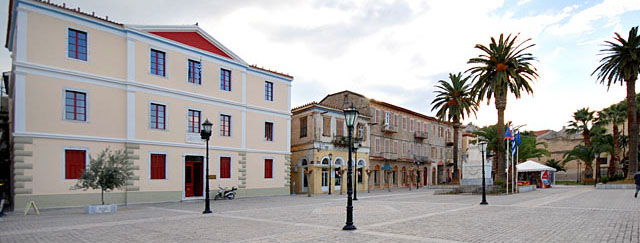 The Square of The Three Admirals (Plateia Trion Navarchon) is dedicated to the memory of Admirals, Kodrigkton of England, Drigny of and Xeiden of Russia, who fighted the Turkish-Egyptian fleet at the Battle of Navarino on 8 October 1827. The square was formed in the days of Ioannis Kapodistrias, by the engineer Stamatis Voulgaris and includes important buildings and monuments. In the middle of the square stands the tomb monument containing the bones of Demetrius Ypsilantis, who was one of the leading figures of the Hellenic Revolution. Ypsilantis, who died in Nauplion in 1832 hit by hereditary disease at age 40, was originally buried in the narthex of the church of St. George. But in 1843, his bones were deposited with an official ceremony, to this monument which was built in Vienna, at the request of his brother, George Ypsilantis. In the square there are notable neoclassical buildings, of which stands the building that now houses the Town Hall. Next, on Basileos Constantine Str. 32, was the pharmacy of the Italian philhellene Bonifaccio Bonafin who embalmed the dead body of the murdered gorvernor Ioannis Kapodistrias.
The Square of The Three Admirals (Plateia Trion Navarchon) is dedicated to the memory of Admirals, Kodrigkton of England, Drigny of and Xeiden of Russia, who fighted the Turkish-Egyptian fleet at the Battle of Navarino on 8 October 1827. The square was formed in the days of Ioannis Kapodistrias, by the engineer Stamatis Voulgaris and includes important buildings and monuments. In the middle of the square stands the tomb monument containing the bones of Demetrius Ypsilantis, who was one of the leading figures of the Hellenic Revolution. Ypsilantis, who died in Nauplion in 1832 hit by hereditary disease at age 40, was originally buried in the narthex of the church of St. George. But in 1843, his bones were deposited with an official ceremony, to this monument which was built in Vienna, at the request of his brother, George Ypsilantis. In the square there are notable neoclassical buildings, of which stands the building that now houses the Town Hall. Next, on Basileos Constantine Str. 32, was the pharmacy of the Italian philhellene Bonifaccio Bonafin who embalmed the dead body of the murdered gorvernor Ioannis Kapodistrias.
Behind the monument of Ypsilantis, in the western part of the square, one can see the statue of the first King of Greece, Otto, second son of King Ludwig of Bavaria. The young king landed at Nauplion on 25 January 1833, and stayed briefly in the city until 1834. Approximately at the location installed the statue of Otto, between the streets Basileos Constantine and Amalias, was formerly one of the most important buildings of Nafplion, the Kyverneio (Governorate) or “Palataki”, which was destroyed by fire in 1929. Kyverneio constructed in 1829, exactly one hundred years before its destruction, designed by the Italian architect Pasquale Ippoliti, to house the offices of the newly formed Greek government and the home of the first Governor of Greece, Ioannis Kapodistrias. Its erection became even at the expense of himself the Governor, but also by sponsoring of expatriate Greeks. Both its architectural appearance and the interior exuded simplicity. It was a neoclassical building, with a pronounced horizontal axis. Inside the impression caused by the simple furnishing, after the order of the Governor himself. When Kapodistrias was murdered here in the central hall of Kyverneio, was placed his embalmed body on popular pilgrimage shrine. When the young King Otto arrived in Nafplio, he stayed, also, in Kyverneio. Then the Kyverneio named ‘Royal Palace’, while the people called it “Palataki” (Small Palace) name by which it became known today.
Arvanitia of Nafplio
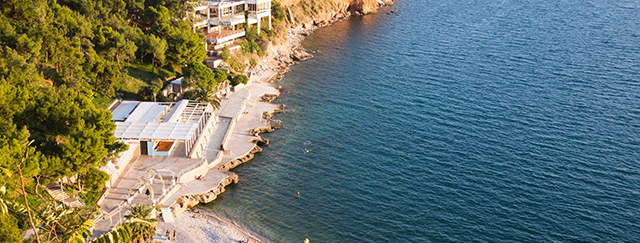 The “round of Arvanitia”, as it is called by the inhabitants of the city, is the favorite promenade of residents of Nafplion. It starts at the end of the beach and ends at the square of Arvanitia, with a total distance of around 1 km. Along the route is dominated by rocks fo Akronafplia with the imposing walls. Shortly before the mid-walking, one encounters on the rocks, a small chapel, which is a favorite pilgrimage to both city residents and visitors. It is Panagitsa, Panagia of the Cave, Santa Maria della Grotta of the Venetians. The view to the bay of Argoliko is unique from here. The tour ends at the square of Arvanitia. The region, according to tradition, named Arvanitia because of its rocks, in 1779, said the Captain Pasha threw the Albanian mercenaries who ravaged the region. In reality, the name stems from the fact that in this region, which was outside the walls and east of “Pyli tis Ksiras” (Land Gate), lived Albanians, since the first years of Venetian domination. Below the square is an organized beach where one can enjoy swimming. After the square of Arvanitia, you can continue your walk to the east foothills of Palamidi, and reach a total distance of 2.7 km around the beach of Karathonas. If anyone still wants to return to the old city, may descend from the square of Arvanitia to Staikopoulos Park and “Pyli tis Ksiras” (Land Gate).
The “round of Arvanitia”, as it is called by the inhabitants of the city, is the favorite promenade of residents of Nafplion. It starts at the end of the beach and ends at the square of Arvanitia, with a total distance of around 1 km. Along the route is dominated by rocks fo Akronafplia with the imposing walls. Shortly before the mid-walking, one encounters on the rocks, a small chapel, which is a favorite pilgrimage to both city residents and visitors. It is Panagitsa, Panagia of the Cave, Santa Maria della Grotta of the Venetians. The view to the bay of Argoliko is unique from here. The tour ends at the square of Arvanitia. The region, according to tradition, named Arvanitia because of its rocks, in 1779, said the Captain Pasha threw the Albanian mercenaries who ravaged the region. In reality, the name stems from the fact that in this region, which was outside the walls and east of “Pyli tis Ksiras” (Land Gate), lived Albanians, since the first years of Venetian domination. Below the square is an organized beach where one can enjoy swimming. After the square of Arvanitia, you can continue your walk to the east foothills of Palamidi, and reach a total distance of 2.7 km around the beach of Karathonas. If anyone still wants to return to the old city, may descend from the square of Arvanitia to Staikopoulos Park and “Pyli tis Ksiras” (Land Gate).
Grand Street of Nafplio
Megalos Dromos, The Great Street, currently named Basileos Constantinou Str., created in accordance with European standards, by initiative of the first Governor of the Modern Greek nation, Ioannis Kapodistrias. It was the most important street of the city in the 19th century, so it was called “Great”. For its opening the church of St. Niki was demolished, which was in the middle of this street. The Great Street was leading from the Kyverneio to Syntagma Square, the central square of Nafplion, with completion the building of the Venetian arsenal, today’s Archaeological Museum. Along the “Great Street” are still preserved some houses of the Kapodistrian and Ottonian period. They are built in neoclassical style, with the characteristic symmetry in faces. In the middle of the “Great Street” was formerly the House of Ksenos, which was the first house of the Governor Ioannis Kapodistrias. This house was burned down in 1862. Another important neoclassical building is the Municipal Gallery. It is dated since the Venetian period of Nafplion, but converted at the period of Kapodistrias. Its gate is simple, Venetian Renaissance style. Today, the building has been granted in the Administration of the Department of Theatre Studies of the University of Peloponnese. The “Great Street” along the parallel Staikopoulou street, are an important passage for residents and visitors of the city, with shops along both these streets, where one can sit in one of the nice bars of the “Great Street” or taverns of Staikopoulou street and go shopping. In spite of the time, the residents of Nafplio still call this road “Great”, causing the surprise to the guests of the city, as the road is no longer significant; the parallel Amalias Avenue is much greater.
Bourtzi
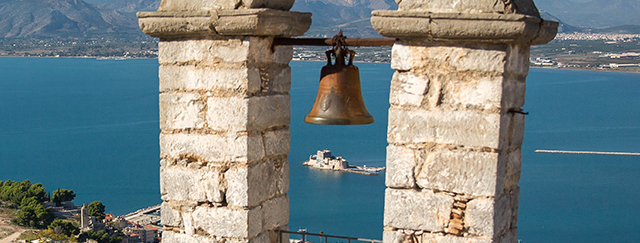 The fortress on the sea, which is known with the Turkish name Bourtzi, which means tower, is a trademark of the city of Nafplion. Initially in this islet, which lies in the middle of the harbor, there was a Byzantine church dedicated to St. Theodore. The Venetians realizing its strategic location to protect the harbor, built a tower around 1473, on this rocky island. The Italian architect Antonio Gabela, who had, also, undertaken the building of the Castle of Toroni, designed the fortress, which was completed by the engineer Brankaleone. The design of the fortress is attached to the elongated shape of the rocks. The center of the fort is occupied by a tower in the shape of an irregular hexagon, with shaded cannons either side of it, on a lower level. The interior is three-storey tower and communication between the floors is done with ladders for safety reasons. The need of water was covered by a large circular tank located in the basement of the tower. The entrances were to the north and south. In the north-east was formed a small cove to access safely the fort. Among the fort and the mole was a narrow passage which was closing with chain, for the safety of the harbor from enemy ships. The fort has several modifications and repairs carried out at different times. The Turks surrounded the Bourtzi with the so-called porporella, underwater barrier of stones, so as not to allow the approach of large ships. In the 18th century, the Venetians made additions to Bourtzi. They arised the central tower and almost the entire island was covered with fortifications.
The fortress on the sea, which is known with the Turkish name Bourtzi, which means tower, is a trademark of the city of Nafplion. Initially in this islet, which lies in the middle of the harbor, there was a Byzantine church dedicated to St. Theodore. The Venetians realizing its strategic location to protect the harbor, built a tower around 1473, on this rocky island. The Italian architect Antonio Gabela, who had, also, undertaken the building of the Castle of Toroni, designed the fortress, which was completed by the engineer Brankaleone. The design of the fortress is attached to the elongated shape of the rocks. The center of the fort is occupied by a tower in the shape of an irregular hexagon, with shaded cannons either side of it, on a lower level. The interior is three-storey tower and communication between the floors is done with ladders for safety reasons. The need of water was covered by a large circular tank located in the basement of the tower. The entrances were to the north and south. In the north-east was formed a small cove to access safely the fort. Among the fort and the mole was a narrow passage which was closing with chain, for the safety of the harbor from enemy ships. The fort has several modifications and repairs carried out at different times. The Turks surrounded the Bourtzi with the so-called porporella, underwater barrier of stones, so as not to allow the approach of large ships. In the 18th century, the Venetians made additions to Bourtzi. They arised the central tower and almost the entire island was covered with fortifications.
Grimani Bastion
 The bastion, named after the Venetian governor Francesco Grimani, is built on the northeast corner of the Castle of Toroni. The construction began in 1702 and completed in 1706, in the reconstruction of the eastern wall of the lower city during the second Venetian domination. Grimani Bastion or San Antonio had four cannons that protected the castle of Akronafplia and narrow road leading to the Land Gate. It is quadrangular and the lower part is built with large stones protruding, in the style of so-called rustic, while above the stones followed almost isodomic provision. In northern and eastern wall stands the hallmark of the Venetian fortifications, the emblem with the embossed winged lion of Venice, a symbol of their patron evangelist Mark.Today, the bastion is still in good condition and is visible from the Land Gate and the Staikopoulos Park.
The bastion, named after the Venetian governor Francesco Grimani, is built on the northeast corner of the Castle of Toroni. The construction began in 1702 and completed in 1706, in the reconstruction of the eastern wall of the lower city during the second Venetian domination. Grimani Bastion or San Antonio had four cannons that protected the castle of Akronafplia and narrow road leading to the Land Gate. It is quadrangular and the lower part is built with large stones protruding, in the style of so-called rustic, while above the stones followed almost isodomic provision. In northern and eastern wall stands the hallmark of the Venetian fortifications, the emblem with the embossed winged lion of Venice, a symbol of their patron evangelist Mark.Today, the bastion is still in good condition and is visible from the Land Gate and the Staikopoulos Park.
House of Armansperg
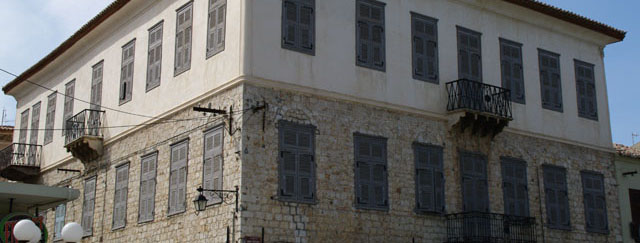 This is one of the most important mansions of the Ottonian period of Nafplio. The building dates from the Second Venetian domination, but in 1831 it was rebuilt and was added the second floor. In this house lived the President of Regency, Count Josef Ludwig von Armansperg, in the years 1833 and 1834. Armansberg was a controversial figure, as he was known by in the intrigues and authoritarian politics. The house was, according to reports of that time, one of the largest city and the interior design is not deficient in any of the great houses of Europe. Here often take place banquets and dances with the rare, for the season, piano music. Facing the house Armansperg was formerly the residence of Georg Ludwig von Maurer, Deputy of Regency.
This is one of the most important mansions of the Ottonian period of Nafplio. The building dates from the Second Venetian domination, but in 1831 it was rebuilt and was added the second floor. In this house lived the President of Regency, Count Josef Ludwig von Armansperg, in the years 1833 and 1834. Armansberg was a controversial figure, as he was known by in the intrigues and authoritarian politics. The house was, according to reports of that time, one of the largest city and the interior design is not deficient in any of the great houses of Europe. Here often take place banquets and dances with the rare, for the season, piano music. Facing the house Armansperg was formerly the residence of Georg Ludwig von Maurer, Deputy of Regency.
Land Gate of Nafplio
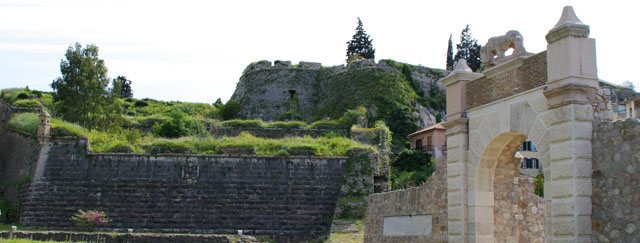 The Land Gate was built in 1708 by the French engineer Lassale and it is the successor of the first gate of Venetian domination. It was the only entrance to the lower city by land and the gate closed after sunset. Anyone who remained outside were forced to spend the night outside the walls, usually in a suburb of Providence. In front of the gate there was a water ditch that ran round the east walls of the city and the access to the gate was by movable wooden bridge. The Gate demolished progressively from 1894 to 1897. Around 1894 the moat which skirted it, was rammed. From the Gate survived only a few architectural members and sculptures, such as the stone lion of the crowning, which is missing its head, wings and tail, and the plate with the emblem of the Venetian governor Grimani with the date 1708. Today, the outside face of the gate has been rebuilt, after special study about how it was in its original form. Overall, the look of the gate is simple, arched, with two pilasters either side, while on its the peak it is decorated with a sculpted lion, symbol of the Republic of Venice. Near the left pilaster of the gate, there is votive plaque commemorating liberation of Nafplion from the Venetians with commander Francesco Morozini in the year 1687.
The Land Gate was built in 1708 by the French engineer Lassale and it is the successor of the first gate of Venetian domination. It was the only entrance to the lower city by land and the gate closed after sunset. Anyone who remained outside were forced to spend the night outside the walls, usually in a suburb of Providence. In front of the gate there was a water ditch that ran round the east walls of the city and the access to the gate was by movable wooden bridge. The Gate demolished progressively from 1894 to 1897. Around 1894 the moat which skirted it, was rammed. From the Gate survived only a few architectural members and sculptures, such as the stone lion of the crowning, which is missing its head, wings and tail, and the plate with the emblem of the Venetian governor Grimani with the date 1708. Today, the outside face of the gate has been rebuilt, after special study about how it was in its original form. Overall, the look of the gate is simple, arched, with two pilasters either side, while on its the peak it is decorated with a sculpted lion, symbol of the Republic of Venice. Near the left pilaster of the gate, there is votive plaque commemorating liberation of Nafplion from the Venetians with commander Francesco Morozini in the year 1687.
πηγή: nafplio.gr
Palamidi Nafplio
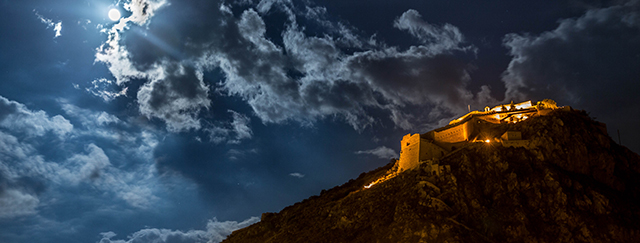 The fortress of Palamidi, which is kept in excellent condition, is one of the greatest achievements of Venetian fortification architecture. The hill of Palamidi, which owes its name to the Homeric war hero, Palamidis, appears to have systematically entrenched until the years of of the Second Venetian Domination. The construction of the fort was done the days of the Venetian General Intendant of the Fleet, Augustinos Sagredos, from 1711 until 1714, making the fortification of the fortress real achievement, both in terms of fortification and to speed of the construction. The engineers Ziaxich and Lassale drew a fortress which is based on a mutually supported ramparts, which are developed incrementally in the East-West axis and linked by walls. The total of eight bastions of the fortress are independent, so that if one of them was occupied, the defense maintained by others. The main bastion of San Andreas, was the garrison headquarters and was the finest equipped. Here is the church of St. Andrea, originally dedicated to San Gerardo, the patron saint of the family of Sagredon. Note that the names of the bastions were changing depending on the holders of the fort. Apart from the bastion of San Andreas, the Venetians built the battlements of Leonidas and Miltiadis to the north, the northwest bastion Rober, Themistocles to the south and Achilles to the east. The bastion Epameinondas was completed during the Turkish Domination, while bastion Fokion constructed entirely by the Turks. Let us note that during Turkish Domination, Christians were not allowed to enter the fortress. From Palamidi began the liberation of the city from the Turks, after a long siege. The night of 29th November 1822, a group of Greek warriors led by Staikos Staikopoulos conquered Palamidi by surprise. First, Demetrius Moschonisiotis set foot in the fort from the bastion Achilles. The afternoon of 30th November, having cleared the debris from the ruined chapel of Venetians which was dedicated to San Gerardo, celebrated thanksgiving and the chapel was dedicated in memory of Apostle Andreas, beacuse is commemorated on 30th November, the day on which the city became Greek. Since then and every year this day is celebrated the liberation of the city with praise in this historic church. However, Palamidi despite being a great fort it was, also, place of grim prison. In 1833, during Regency, Theodoros Kolokotronis was imprisoned in the bastion of Miltiadis, probaly, with the alleged charges of treason. Around 1840, Miltiadis bastion, which is the largest in size, became one of the toughest prisons, which operated there until 1926 or so. Another prison, was at the bastion of San Andreas, where prevailed better conditions. Today access to the fort is possible, either through highway leading to the eastern gate or from the known scale located on the west side, east of Grimani bastion. This scale, that the tradition wanted to have 999 steps, because the 1000th was threw by Kolokotronis’ horse, actually has fewer steps and constructed at the time of Otto by convicts who were imprisoned in Palamidi, under the supervision of the Bavarian army. From here there is an excellent view to the Castle of Akronafplia. Above the fort one can now admire, including the imposing bastions, the historic church of St. Andreas and the impressive tanks which still collect the rain water of the hill.
The fortress of Palamidi, which is kept in excellent condition, is one of the greatest achievements of Venetian fortification architecture. The hill of Palamidi, which owes its name to the Homeric war hero, Palamidis, appears to have systematically entrenched until the years of of the Second Venetian Domination. The construction of the fort was done the days of the Venetian General Intendant of the Fleet, Augustinos Sagredos, from 1711 until 1714, making the fortification of the fortress real achievement, both in terms of fortification and to speed of the construction. The engineers Ziaxich and Lassale drew a fortress which is based on a mutually supported ramparts, which are developed incrementally in the East-West axis and linked by walls. The total of eight bastions of the fortress are independent, so that if one of them was occupied, the defense maintained by others. The main bastion of San Andreas, was the garrison headquarters and was the finest equipped. Here is the church of St. Andrea, originally dedicated to San Gerardo, the patron saint of the family of Sagredon. Note that the names of the bastions were changing depending on the holders of the fort. Apart from the bastion of San Andreas, the Venetians built the battlements of Leonidas and Miltiadis to the north, the northwest bastion Rober, Themistocles to the south and Achilles to the east. The bastion Epameinondas was completed during the Turkish Domination, while bastion Fokion constructed entirely by the Turks. Let us note that during Turkish Domination, Christians were not allowed to enter the fortress. From Palamidi began the liberation of the city from the Turks, after a long siege. The night of 29th November 1822, a group of Greek warriors led by Staikos Staikopoulos conquered Palamidi by surprise. First, Demetrius Moschonisiotis set foot in the fort from the bastion Achilles. The afternoon of 30th November, having cleared the debris from the ruined chapel of Venetians which was dedicated to San Gerardo, celebrated thanksgiving and the chapel was dedicated in memory of Apostle Andreas, beacuse is commemorated on 30th November, the day on which the city became Greek. Since then and every year this day is celebrated the liberation of the city with praise in this historic church. However, Palamidi despite being a great fort it was, also, place of grim prison. In 1833, during Regency, Theodoros Kolokotronis was imprisoned in the bastion of Miltiadis, probaly, with the alleged charges of treason. Around 1840, Miltiadis bastion, which is the largest in size, became one of the toughest prisons, which operated there until 1926 or so. Another prison, was at the bastion of San Andreas, where prevailed better conditions. Today access to the fort is possible, either through highway leading to the eastern gate or from the known scale located on the west side, east of Grimani bastion. This scale, that the tradition wanted to have 999 steps, because the 1000th was threw by Kolokotronis’ horse, actually has fewer steps and constructed at the time of Otto by convicts who were imprisoned in Palamidi, under the supervision of the Bavarian army. From here there is an excellent view to the Castle of Akronafplia. Above the fort one can now admire, including the imposing bastions, the historic church of St. Andreas and the impressive tanks which still collect the rain water of the hill.
Beach - Port of Nafplio
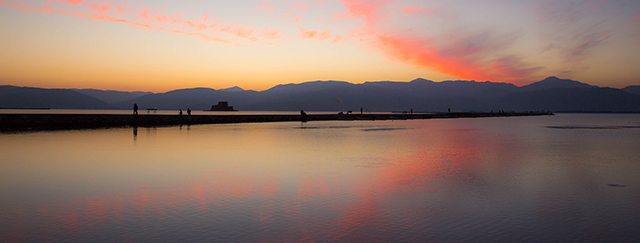 During the First Venetian domination, on the present beach was formed an artificial breakwater, which left a fairway between this and Bourtzi. This channel was closed each evening with chain and for this reason, the port was called Porto Katena, “Port with the chain”. Within the breakwater was formed the port of Nafplion, except the period of the second Turkish Domination, was one of the most important trading posts of the Peloponnese. Below the hotel “Amfitryon”, in the middle of the beach there was great reservoir of the early 18th century, one of the most impressive creations of the Venetians in the city. Today, the beach is to sit in one of the beautiful cafeterias and enjoy the beautiful views of the Bourtzi, especially at sunset.
During the First Venetian domination, on the present beach was formed an artificial breakwater, which left a fairway between this and Bourtzi. This channel was closed each evening with chain and for this reason, the port was called Porto Katena, “Port with the chain”. Within the breakwater was formed the port of Nafplion, except the period of the second Turkish Domination, was one of the most important trading posts of the Peloponnese. Below the hotel “Amfitryon”, in the middle of the beach there was great reservoir of the early 18th century, one of the most impressive creations of the Venetians in the city. Today, the beach is to sit in one of the beautiful cafeterias and enjoy the beautiful views of the Bourtzi, especially at sunset.
Ancient Theatre of Epidavros - Ancient Epidaurus - Little Theatre
 Going from Nafplion to Epidaurus Theatre, it is worth to stand and walk on the Early Mycenaean Bridge of Kazarma in Arcadia, which connected Mycenae and Tyrintha with Epidaurus. Arriving at Lygourio visit the Museum of Natural History. Continue to arrive in one of the most important monuments of Ancient Greece, the Theater at ASKLIPIIO of EPIDAURUS The prosperity brought by Asklipios did Epidaurus able to construct cultural monuments: the huge theater that impressed Pausanias for its symmetry and beauty, which is used for dramatic performances, the ritual restaurant, the showers and a palestra. The theater was designed by Polykleitos the Younger in the 4th century BC. The original 34 rows were extended in Roman times, with additional 21 lines. The theater is admired for its amazing acoustics, which allows almost perfect clarity of the spoken words from the proscenium or the scene to all the 15,000 spectators, regardless of the order of their positions. It is worth watching a theatrical performance in the summer. Continue for the Little Theater of Epidaurus. The Little Theatre of Ancient Epidaurus is situated in the village of Old Epidaurus. Each July, here in the little theater, there are important musical events of the Ministry of Development, which integrates them to the program of summer cultural activities of the GNTO, which in turn, since 1998 has awarded the organization of production & executing programs “Musical July” to the Athens Concert Hall. Very close to small ancient theater of Epidaurus, on the north side of the beach lies the sunken city, all you need is a mask and snorkel. The south side of the beach is rocky and one can visit there many beaches by yacht or boat.
Going from Nafplion to Epidaurus Theatre, it is worth to stand and walk on the Early Mycenaean Bridge of Kazarma in Arcadia, which connected Mycenae and Tyrintha with Epidaurus. Arriving at Lygourio visit the Museum of Natural History. Continue to arrive in one of the most important monuments of Ancient Greece, the Theater at ASKLIPIIO of EPIDAURUS The prosperity brought by Asklipios did Epidaurus able to construct cultural monuments: the huge theater that impressed Pausanias for its symmetry and beauty, which is used for dramatic performances, the ritual restaurant, the showers and a palestra. The theater was designed by Polykleitos the Younger in the 4th century BC. The original 34 rows were extended in Roman times, with additional 21 lines. The theater is admired for its amazing acoustics, which allows almost perfect clarity of the spoken words from the proscenium or the scene to all the 15,000 spectators, regardless of the order of their positions. It is worth watching a theatrical performance in the summer. Continue for the Little Theater of Epidaurus. The Little Theatre of Ancient Epidaurus is situated in the village of Old Epidaurus. Each July, here in the little theater, there are important musical events of the Ministry of Development, which integrates them to the program of summer cultural activities of the GNTO, which in turn, since 1998 has awarded the organization of production & executing programs “Musical July” to the Athens Concert Hall. Very close to small ancient theater of Epidaurus, on the north side of the beach lies the sunken city, all you need is a mask and snorkel. The south side of the beach is rocky and one can visit there many beaches by yacht or boat.
Mycenae - Ancient Theater of Argos
 MYCENAE
MYCENAE
In the cove of the plain of Argolis is the most important Mycenaean archaeological site. The crown jewel of Mycenae, the famous Lion Gate, the entrance of the mycanaean acropolis, which bears the oldest example of monumental sculpture in Europe. The wider area of the citadel bears royal tombs, foundations Mycenaean dwellings, barn, the palace complex and in the area outside the citadel there are also a number of graves with the largest tomb of the Lions of Aegisthus and Clytemnestra and reputedly buried “Atreus” or tomb of Agamemnon, where was found the golden funerary mask which is considered to be the face of Agamemnon.
ANCIENT THEATRE ARGOS
Built in the late 4th century BC southwest of the castle of Larisa. Impressive building with unique architecture that makes it stand out, because all the seats of the spectators benches, carved in rock. Could accommodate 20,000 people. In the same area are the Roman Baths, the Ancient Odeon, the Ancient Agora and the Criterion. A little further north lies the hill “Shield”, home to the prehistoric temple of Deirada with the Mycenaean tombs.
ANCIENT MARKET OF ARGOS
The Ancient Agora of Argos began to run since the 6th century. BC south of the city in a central place where the roads ended by the Heraion, the Corinth and Tegea. The building project was completed in late fourth century BC. During the Classical and Hellenistic times the market lays down galleries and buildings which are difficult to distinguish today under the later building phases.
Τolo - Ancient Assini (Kastraki)
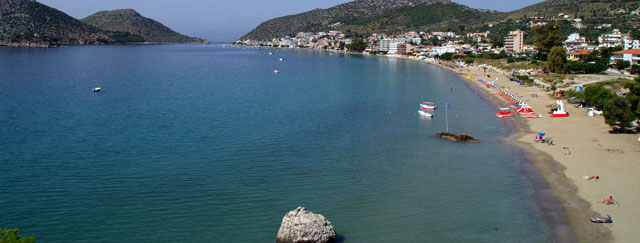 Tolo
Tolo
The Tolo is a village in Greece on the Peloponnesian peninsula. Although it is a relatively new addition to the map, modern history, starting in 1830, the area where it is and its environs are there from many years ago.
Today, Tolo is a very recognizable location. Its characteristic is the two islands that adorn the bay, the Koronisi with the chapel of the Holy Apostles and Romvi or island of Aphroditis. From the mid 20th century, with its natural beauty and location allowing easy access to nearby archaeological sites, Tolon saw the beginning of the tourist industry and evolved into the popular summer resort. It is now offering hospitality to tourists from around the world.
Ancient Assini – Kastraki
Near present Tolo, during the Mycenaean period Asini associated by street with Mycenae and was a seaport. Conquered and destroyed by the Argives. It was rebuilt and walled during Hellenistic times. Excavations have revealed remains of fortifications second millennium and the 3rd century BC, developed since the Bronze Age, as shown by the finds from excavations flourished in Mycenaean, Geometric, and PG Years. Today there are traces of prehistoric settlement, parts of the majestic courtyard of the citadel, and Hellenistic towers that maintain their medieval repairs. On a hill opposite the citadel excavated Mycenaean, Hellenistic, Roman tombs. Many of the finds from the excavations of Asini are now in Sweden, especially from the excavations of 1920, while others are exhibited in the Archaeological Museum of Nafplion.
Beaches
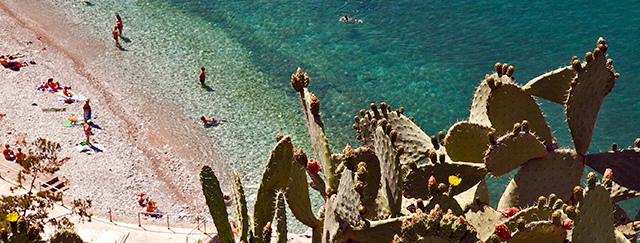 1. Arvanitia
1. Arvanitia
Beach Type: Thick stoned in the center. Rocky at the edges, where access to the sea is with small metal stairs. Medium-sized beach, sandy with small stones. Sandy seabed.
2. Neraki
Type of Beach: Rocky at the edges and sand in the center with small stones. Very compact beach. Sandy seabed. It is worth to notice the rich seabed.
3. Karathona Beach
Beach Type: Sandy, as its seabed. Very long beach with shallow waters. Suitable for families with children.
4. Psili Ammos – Tolo
Beach Type: Sansy, as the seabed. Very fine sand. Long beach with shallow waters. Suitable for families with children.
5. Kastraki Beach – Ancient Assini
Beach Type: Thick stoned. Rocky at the edges. Compact beach. Rocky seabed.
6. Plaka
Beach type: Fine and coarse stone, sand. Very large in size, where the texture of the beach changes at regular short intervals. Seabed mostly sandy with some plates in some places.
7. Kondili
Beach type: Fine and coarse stone, mixed with sand. Very large in size. Seabed mainly sandy. Suitable for families with children.
8. Kandia
Beach type: Fine and coarse stone, mixed with sand. Very large in size. Seabed mainly sandy. Suitable for families with children.
9. Iria Beach
Beach type: Fine and coarse stone, mixed with sand. Very large in size. Seabed mainly sandy and rocky in several places. Suitable for families with children.
Tiryns
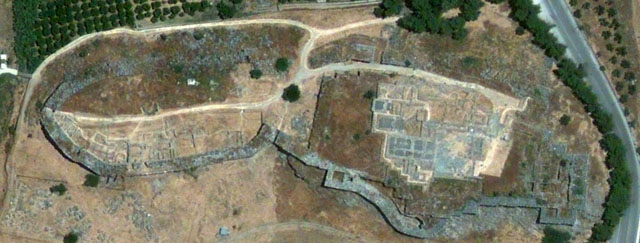 The low hill of Tiryns, in the 8th km of the road Argos-Nafplio, was continuously inhabited since the Neolithic Age to late antiquity. In prehistoric times, the area flourished mainly during the early and late Bronze Age. In the second phase of EH era (2700-2200 BC) must have been here an important center of densely populated and built a unique circular structure with diameter of 27 meters, on top of the hill. During the Late Bronze Age fortified hill gradually surrounds within the “Cyclopean” walls of the palace complex and other buildings used primarily by the ruling class as places of worship, warehouses and workshops as well as homes. In historical times, Tiryns, although it should be in the form of an organized political community, could not compete with Argos, which destroyed it in the first half of the fifth century exiling its residents. The traveler Pausanias, who visited Tiryns in the 2nd century AD found it deserted. During the Byzantine period established in the Upper Acropolis a cemetery church and possibly a small class settlement west of the Acropolis. The end of the, insignificant at the present, village can be connected with the conquest of Argos by the Turks in 1379 AD. In Venetian sources Tiryns referred to as “Napoli vecchio”, while the name given Tiryns again in modern times by replacing the usual name “Palaiokastro”. The investigations of the German Archaeological Institute and the Greek Archaeological Service, from 1876 until now, revealed a major Mycenaean citadels and tracking stages of the culture of prehistoric and historic periods of Argolida. After the pioneers Heinrich Schliemann and Wilhelm Dorpfeld (1884-1885), the area investigated in the first half of the twentieth century by Georg Karo and Kurt Müller.
The low hill of Tiryns, in the 8th km of the road Argos-Nafplio, was continuously inhabited since the Neolithic Age to late antiquity. In prehistoric times, the area flourished mainly during the early and late Bronze Age. In the second phase of EH era (2700-2200 BC) must have been here an important center of densely populated and built a unique circular structure with diameter of 27 meters, on top of the hill. During the Late Bronze Age fortified hill gradually surrounds within the “Cyclopean” walls of the palace complex and other buildings used primarily by the ruling class as places of worship, warehouses and workshops as well as homes. In historical times, Tiryns, although it should be in the form of an organized political community, could not compete with Argos, which destroyed it in the first half of the fifth century exiling its residents. The traveler Pausanias, who visited Tiryns in the 2nd century AD found it deserted. During the Byzantine period established in the Upper Acropolis a cemetery church and possibly a small class settlement west of the Acropolis. The end of the, insignificant at the present, village can be connected with the conquest of Argos by the Turks in 1379 AD. In Venetian sources Tiryns referred to as “Napoli vecchio”, while the name given Tiryns again in modern times by replacing the usual name “Palaiokastro”. The investigations of the German Archaeological Institute and the Greek Archaeological Service, from 1876 until now, revealed a major Mycenaean citadels and tracking stages of the culture of prehistoric and historic periods of Argolida. After the pioneers Heinrich Schliemann and Wilhelm Dorpfeld (1884-1885), the area investigated in the first half of the twentieth century by Georg Karo and Kurt Müller.
In late 1950’s the Superintendent of Antiquities Argolis, Nicholas Verdelis, undertook the project of rehabilitation of the west side of the fortifications which had collapsed and covered by the debris of the old excavations. After the 1967 excavations conferred again at the German Archaeological Institute, which is under the supervision of Ulf Jantzen, Jörg Schofer, Klaus Kilian and Joseph Maran continues investigations including the Lower Citadel and Lower Town. While excavations conducted by the local Archaeological Service in both the archaeological site visited, and the wider region. The revelation, by the excavations, of a monument which was protected for centuries under the soil and long-term exposure neglected maintenance on weather conditions and the actions of visitors, causing significant damage to the archaeological site. By action of 4th Prehistoric and Classical Antiquities, competent regional Office of the Ministry of Culture and the direct support of the Peloponnese region, the monument was included in projects funded by 2nd and 3rd CSF. Decisive was the participation of the German Archaeological Institute, which funded the last decade, studies of the German architect Jan Martin Klessing implemented in Tiryns. During this period a large number of partners (archaeologists, designers, skilled and unskilled workers) participated in the program of upgrading one of the most important archaeological sites of Argolida which has joined the list of World Heritage of Unesco. Besides the responsibility of the Directorate of Restoration of Ancient Monuments of the Ministry of Culture implemented configuration work of the visited site, which now includes organized routes, service buildings for the visitors, new entrance and parking.
Mycenaean acropolis of Midea
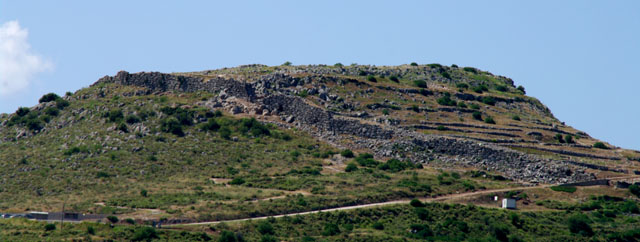 The prominence of Midea between Mycenaean centers of Argolida is strongly emphasized by the researchers of the Mycenaean civilization. Midea considered the third most important fortified Mycenaean Acropolis of Argolis, after Mycenae and Tiryns. The cyclopean fortifications, the findings of recent excavations, the position of the mythology and its connection with the extensive Mycenaean cemetery of the nearby trees, rank it in the major centers of the Mycenaean centers of Mainland Greece.
The prominence of Midea between Mycenaean centers of Argolida is strongly emphasized by the researchers of the Mycenaean civilization. Midea considered the third most important fortified Mycenaean Acropolis of Argolis, after Mycenae and Tiryns. The cyclopean fortifications, the findings of recent excavations, the position of the mythology and its connection with the extensive Mycenaean cemetery of the nearby trees, rank it in the major centers of the Mycenaean centers of Mainland Greece.
The Citadel is built on top of a conical hill at an altitude of 270m. from sea level and 170m. from the surrounding area. Located in the middle of the distance between Mycenae and Tiryns and dominates the eastern edge of Argolida valley. The strategic location with panoramic views enable control of the entire valley and the Argolida bay. In this mainly due to the development and prosperity of Midea during the Mycenaean era.
The cyclopean wall encloses an area of 24,000 sq.m. around and protects the upper acropolis and lower terraces northeast and northwest of the hill. The south side is steep and therefore stayed unwalled. The gates of the Acropolis are the one opposite the other, in the east and west side of the fortification. Besides the gates, the Cyclopean fortification is another major project, which used to supply the Acropolis of Midea and similar structures at Mycenae and Tiryns. This tunnel is opened when the load displacing technique system, in the thickness of the western part of the wall, leading to an underground water source.
During recent excavations surveyed sites near the East Gate and the lower terraces east of the Acropolis. The Eastern Gate cleared from entering landfills, in the form of a simple opening in the wall. Cyclopean ramp built with boulders lead in this gate and Tiryns. A second internal gate is formed between a cyclopean wall and the inner sidewall of the fortification. Immediately after the internal gate searched several rooms, in contact with the wall. As shown by the findings of the rooms were workshops and warehouses. In the lower east terraces revealed a large rectangular building with particular significance to the “mansion”. Was destroyed along with the rooms near the East Gate by earthquake and fire in the late 13th century BC, as happened in neighboring Tiryns. The earthquake caused extensive damage to the fortifications and all buildings of the Acropolis. Residues skeletons, found crushed by boulders in various parts of the site, belonging to victims of the earthquake. The “palace” was repaired after the destruction and re-used during the 12th century BC.
The West Gate of the Acropolis was revealed throughout during recent excavations. Formed between the termination of the southwest part of the wall and a solid retaining wall, covering the steep cliff. Through the thickness of the wall ends at the gate is formed inside the room, which served as a guard and storage space, as evidenced by jars and other large vessels chondrotechna found. An impressive solid rampart protected the gate and guardhouse. The walls of the orifice bore the gate decorated with painted plaster, as evidenced by the numerous fragments of wall paintings collected by the destruction layer.
Under the Acropolis inside the West Gate, the excavations revealed a complex of 15 rooms built in successive terraces, parallel to the wall. It consists of two wings on either side of a central corridor, crossed constructed conduit.
The best-kept rooms, which appeared to be underground, located in the wing, built in contact with the wall. Their walls are preserved to some height and were covered with painted plaster, as shown by the fragments of frescoes found.
In the rooms of the complex found in large quantities chondrotechni leptotechni and pottery, dating to the Late IIIB2 period, ie in the second half of the 13th century BC Also found pots figurative style, similar to those of other major centers Argolic (Mycenae, Tiryns, Berbati). There were also stone and lead utensils and many bronze, stone and bone tools and pieces of rough gemstones and womb of steatite for jewelery.
Other interesting findings are jewelry, such as beads of various types, seals, fragments of Minoan rhyton shaped triton of amethyst, fragments of frescoes, tile roof and numerous clay figurines. Of particular interest is a big wheel idol god, type the few separate figurines, which are found in shrines of Mycenae, Tiryns and Phylakopi Milos. Of particular importance is a clay seal and a storage jar with inscriptions in Linear B script. The findings however show that most of the rooms of the complex were workshops and warehouses.
Terrace to the southwest slope of the citadel and found parts of three other buildings, built across a road, which were also destroyed by the earthquake and the strong fire of the late 13th century. BC In this area was part of the drainage system with built pipelines and underground storage tank. The findings of the buildings was plentiful pottery, which dates to the second half of the 13th century. BC, clay figurines, which are distinguished by some that belong to large wheeled figurines of female deities, stone and metal ware, jewelry, gems, tools and other artifacts that reveal the function of specialized laboratories, such as fragments gemstones and other raw materials . Very important finding is a prismatic clay seal depicting a lion attacking a bull and with inscriptions in Linear B script, which include the word “Hall”.
In the terrace of the Upper Acropolis revealed important building remains and graves of the Early Helladic and Middle Helladic period (3200-1600 BC) with abundant pottery, including several Neolithic sherds. These findings suggest that Promykinaikoi villages of Midea developed on top of the hill.
The results of recent excavations, especially the discovery of pottery and seals with inscriptions in Linear B script, indicating that Midea was, along with Mycenae and Tiryns, an administrative and economic center.
Other evidence linking Midea these two citadels of the type and quality of findings, which show considerable artistic and craft production, the apparent relations with other centers in the Argolid, the Aegean and the East generally, and the existence of sites worship, as indicated by the large trolleys female figurines and other religious symbols.
Mycenaean Cemetery of Dendra
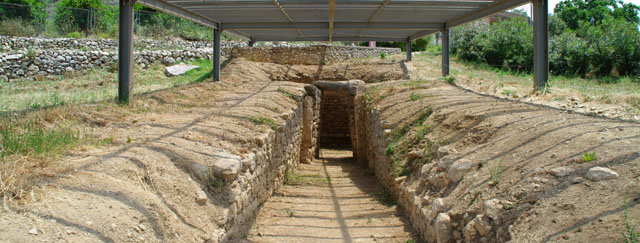 To Mycenaean cemetery of Dendra extends to the southwest slope of a low hill west of the acropolis of Midea. The excavated portion includes a vaulted chamber tombs and sixteen.
To Mycenaean cemetery of Dendra extends to the southwest slope of a low hill west of the acropolis of Midea. The excavated portion includes a vaulted chamber tombs and sixteen.
The excavations began in the spring of 1926 by the Swedish archaeologist Axel W. Persson. That summer investigated the vaulted tomb and next year three chambered. Two other graves stretching northeast and outside the boundaries of organized today the site were investigated by N. Bertie, in the autumn of 1927. In 1937, Persson also excavated a chamber tomb in 1939 and five others.
In 1960 he investigated the famous “Tomb of armor” by N. Verdelis and two other chambered tombs from the Swedish archaeologist P. Åström.
Excavated in 1977 by E. Protonotarios – Deilaki two chambered tombs and mounds that surround them.
The chambered tombs were carved into the soft rock at closely spaced on the hillside. They consist of three parts: the way the orifice and the chamber.
The tombs differ both in size, the smallest has a length of 8 and the largest nearly 20 feet, and in the manner developed by the burial chamber. Have downhill roads converging walls and quadrilateral burial chambers. The entrance blocked with dry wall. Plastered walls and floors, pitched or flat roof, benches and niches and side chambers, suggesting that these tombs imitate the houses of the living.
On the floor of the chambers are often opened additional pits. The tombs were used for multiple burials over long periods. Important information on the funerary rites of the Mycenaean era gives us the graves of three pairs of horses found in proximity to the graves.
The excavation yielded to many important discoveries such as jewelry, gems, weapons, tools and utensils of gold, silver, bronze, alabaster glass, ivory, faience and semi-precious stones and interesting specimens of pottery and figurines, not finding top is the famous armor . The offerings in conjunction with the construction of monumental tombs suggest a society with complex social structure.
The graveyard of trees is one of the richest Mycenaean cemeteries in the Peloponnese and can be compared with the older cemeteries Prosymna of Deiradas of Nauplia and Assini Argolida and of Aidonia in Corinth. As confirmed by the findings, were in constant use from 1500 to 1180 BC They must have belonged to an important center of Mycenaean civilization, possibly the nearby Midea.
The finds of the Mycenaean cemetery of Dendra kept in the Archaeological Museum of Nafplion and the National Archaeological Museum.
Greek Pyramids
GREEK PYRAMIDS
Located in Greek 9km. southwest of Argos. It is the best preserved pyramid built of unknown utility and practice demonstrates the clear contacts and influences of the Mycenaean and Egyptian civilization. Built on the ancient road connecting Argos to Tegea was probably a form of observation or outpost. Another version wants the pyramid would be Polyandrion, ie tomb, while according to another was friktorias tower that is used to send messages of fire.
CHURCH OF ZOODOCHOU PIGIS
Located at the head of the Argos. It was built in the 1920. The oldest church was destroyed by explosions of ammunition stored in the years 1862 and 1918. The ruins of early Christian basilica, southeast of the church, reveal the existence of life in past centuries.
THE ANCIENT LERNA
Located 10ch.l.m. the village of Millers, are the ruins of ancient Lerna legendary. It is famous in Greek mythology, because the struggle of Hercules with the Hydra. The area has always been famous for its abundant waters that feeds the Argolid plain and the water settled various populations thus inhabited the area in the Neolithic age and reached peak as early as 3000 BC about. The excavations revealed a settlement that flourished in the Early Helladic, Neolithic remains, traces of towers and ruins of the fortifications of the citadel. Feature is the home of tiles, EH era palace was built.
Archaeological Museum
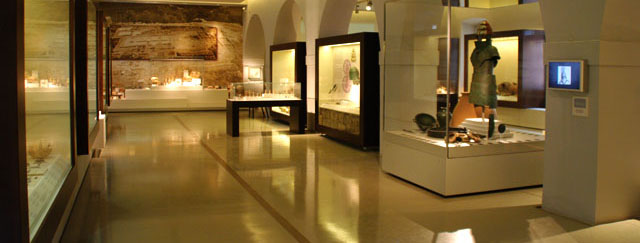 The museum is housed in Nafplio in imposing Venetian stone building which closes with its impressive size and rigid symmetrical form the west side of Syntagma Square. It was built in 1713, during the second Venetian occupation, by the Intendant of the fleet Augustine Sagredos as a repository of the fleet, acccording to the marble Latin inscription which is embedded in the facade. This is one of the finest and best preserved buildings of the Venetian era in Greece.
The museum is housed in Nafplio in imposing Venetian stone building which closes with its impressive size and rigid symmetrical form the west side of Syntagma Square. It was built in 1713, during the second Venetian occupation, by the Intendant of the fleet Augustine Sagredos as a repository of the fleet, acccording to the marble Latin inscription which is embedded in the facade. This is one of the finest and best preserved buildings of the Venetian era in Greece.
The new permanent exhibition of the museum is developed in two rooms with identical floor plan on both floors of the building and is divided into thematic sections, which are cultures that developed in Argolida from prehistory to the utmost and late antiquity.
The oldest exhibit is a cluster of outbreaks of the Paleolithic rockshelters in the gorge of the Klisoura in Prosymna (32000-21000 BC). Remains of the cave Franchthi in Ermionida documenting the transition from hunting in the productive economy.
Exposed stone and bone tools, shells and bones of animal and fish, shell jewelry, bone and stone, the first Neolithic pottery handmade clay and a series of anthropomorphic and zoomorphic clay figurines.
Early Bronze Age or early Helladic Period (3300-2100/2000 BC) is represented with exhibits from Tiryns, Assini to the Berbati and Old Beach. Exhibited characteristic pottery, stamps of the time made of stone, clay and bronze, ceramic fillings, bone tools, marble Cycladic figurines, and the clay plate from Berbati. A special place among them has the unique condenser of Tiryns.
Pottery and other artefacts from the Middle Helladic village of Assini, Pronia of Nafplio, Midea, Tiryns and Berbati cover the entire chronological range of the Middle Helladic period (2100/2000-1600 BC), a culture that formed the Mycenaean background.
The structure of the Mycenaean royal power and administration is outlined through the discoveries of the great Mycenaean centers, Tiryns, Midea and Assini. Prominent religious utensils and idols, among them the impressive female wheeled statuettes from Tiryns and Midea, as well as the famous “Lord of Assini” Linear B script tablets, storage jars, residues of laboratories (dies or semiprecious stones), and mittanic cylinder seals, one talent of copper, objects made of faience, amber, alabaster, which are unimpeachable witnesses of the extensive Mycenaean trade.
War Museum
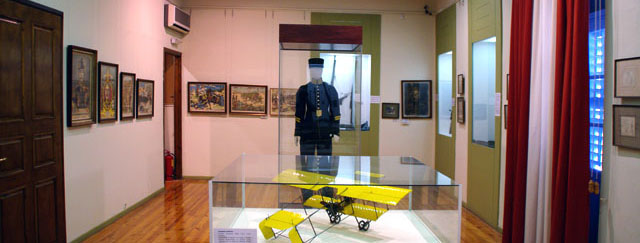 Το Πολεμικό Μουσείο Ναυπλίου, που στεγάζεται στο κτίριο της Πρώτης Σχολής Ευελπίδων (Αμαλίας 22), εγκαινιάστηκε στα τέλη του 1988. Εδώ ο επισκέπτης παρακολουθεί την ιστορία της Στρατιωτικής Σχολής Ευελπίδων και της νεότερης ιστορίας της Ελλάδας, ιδιαίτερα δε τη συμμετοχή των κατοίκων της Αργολίδας στους αγώνες του Ελληνικού Έθνους, από την Ελληνική επανάσταση μέχρι την απελευθέρωση από τα στρατεύματα Κατοχής.
Το Πολεμικό Μουσείο Ναυπλίου, που στεγάζεται στο κτίριο της Πρώτης Σχολής Ευελπίδων (Αμαλίας 22), εγκαινιάστηκε στα τέλη του 1988. Εδώ ο επισκέπτης παρακολουθεί την ιστορία της Στρατιωτικής Σχολής Ευελπίδων και της νεότερης ιστορίας της Ελλάδας, ιδιαίτερα δε τη συμμετοχή των κατοίκων της Αργολίδας στους αγώνες του Ελληνικού Έθνους, από την Ελληνική επανάσταση μέχρι την απελευθέρωση από τα στρατεύματα Κατοχής.
Το Πολεμικό Μουσείο διαθέτει 2 ορόφους στους οποίους παρουσιάζει θεματολογικά τους Αγώνες του Ελληνικού Έθνους.
1ος όροφος
Α) Αφιέρωμα στον πρώτο κυβερνήτη της Ελλάδας Ιωάννη Καποδίστρια
Β) Ναύπλιο. Η πόλη διαδραμάτισε σημαντικό ρόλο στην περίοδο της Ελληνικής Επανάστασης. Ήταν η ψυχή και η καρδιά του Επαναστατημένου Γένους. Σπάνια χαρακτικά απαθανατίζουν εικόνες από το Ναύπλιο και τις οχυρώσεις του.
Γ) Η Πρώτη Σχολή Ευελπίδων ιδρύθηκε με την ονομασία “Κεντρικόν Πολεμικόν Σχολείον” από τον Ιωάννη Καποδίστρια, για να στελεχώσει το Στρατό και το Πολεμικό Ναυτικό. Η σχολή λειτούργησε στο Ναύπλιο από το 1928 μέχρι το 1834. Έργα τέχνης, στολές, όπλα και εικόνες δημιουργούν ένα μικρό αφιέρωμα
Δ) Περίοδος 1821-1897. Το Μάρτιο του 1821 ξεκινά από την Πελοπόννησο ο αγώνας για ανεξαρτησία και ελευθερία. Ο Τσώκρης από το Άργος, οι Νεζαίοι από το Κουτσοπόδι, ο Παπασέρνης από το Κρανίδι και πολλοί Αργολιδείς αγωνίζονται για τη λευτεριά. Το Παλαμήδι και το Ανάπλι ελευθερώνονται από το Σταϊκόπουλο και τον Κολοκοτρώνη. Τα Δερβενάκια και οι Μύλοι γίνονται πεδία μαχών και λαμπρών νικών των Ελλήνων κατά των Τούρκων και των Αιγυπτίων του Ιμπραήμ. Τον Ιανουάριο του 1928 φθάνει στην Αίγινα, προσωρινή έδρα της Ελληνικής Κυβέρνησης.
Ο Ι. Καποδίστριας θεμελιώνει το πρώτο ανεξάρτητο Ελληνικό κράτος. Το έργο διακόπτεται από τη δολοφονία του το Σεπτέμβριο του 1831. Δύο χρόνια αργότερα το Ναύπλιο υποδέχεται το Βασιλιά Όθωνα και το 1834 ο Ναυπλιακός λαός ζει από κοντά την αγωνία της καταδίκης σε θάνατο του Κολοκοτρώνη. Την 1η Δεκέμβρη του 1834 η πρωτεύουσα μεταφέρεται στην Αθήνα. Ο πρόλογος για την έξωση του Όθωνα γράφτηκε με την επανάσταση των κατοίκων του Ναυπλίου (1/2/1862) με πρωταγωνίστρια την Καλλιόπη Παπαλεξοπούλου. Έργα τέχνης, λιθογραφίες, χαρακτικά, όπλα και αρχειακό υλικό καταγράφουν με το δικό τους μοναδικό τρόπο τους ηρωικούς αγώνες των Ελλήνων για Ελευθερία.
Ε) Μακεδονικός Αγώνας (1904-1908). Η ηρωική προσπάθεια των Ελλήνων της Μακεδονίας να προστατέψουν τα πάτρια εδάφη, τη θρησκεία και την ιστορία τους, καθώς η συνδρομή χιλιάδων Ελλήνων εθελοντών συνθέτουν ένα ιδιαίτερο αφιέρωμα. Η Αργολίδα συμμετέχει με αξιωματικούς, όπως τον Σαράντο Αγαπηνό (καπετάν Άγρα) τον κ. Τσολακόπουλο (καπετάν Ρέμπελο) και άλλους. Ο Μακεδονικός Αγώνας κορυφώνεται με τη συμμετοχή του Παύλου Μελά, όπου μετά των ηρωικό του θάνατό του (1904), η υπόθεση της Μακεδονίας γίνεται υπόθεση όλων των Ελλήνων. Έργα τέχνης, λιθογραφίες, φωτογραφίες, όπλα και λάφυρα αναβιώνουν τις προσπάθειες του μικρού νεοσύστατου Ελληνικού Κράτους όχι μόνο να επιβιώσει, αλλά να στηρίξει και να απελευθερώσει σκλάβους αδελφούς στη Θεσσαλία, τη Μακεδονία, την Ήπειρο, τη Θράκη, την Κρήτη.
ΣΤ) Βαλκανικοί Πόλεμοι 1912-13. Οι Βαλκανικοί Πόλεμοι θα συγκλονίσουν το πανελλήνιο. Οι νικηφόρες μάχες και οι ναυμαχίες θα οδηγήσουν τους Έλληνες τροπαιοφόρους και απελευθερωτές στη Θεσσαλονίκη, τα νησιά του Αιγαίου, τα Ιωάννινα. Το 8ο Σύνταγμα (Ναυπλίου) συμμετέχει με Διοικητή το Συνταγματάρχη Αντ. Καμπάνη. Έργα τέχνης, λαϊκές λιθογραφίες, φωτογραφίες, κειμήλια και όπλα διηγούνται ιστορίες για τις Ναυμαχίες του Αιγαίου, τους Ευζώνους, το Μπιζάνι….
Ζ) Α’ Παγκόσμιος Πόλεμος. Ο Α’ Παγκόσμιος Πόλεμος σηματοδοτεί νέους αγώνες για τους Έλληνες, που θα οδηγηθούν σε μεγάλες νίκες έχοντας στο πλευρό τους Συμμάχους. Λιθογραφίες, φωτογραφίες,κειμήλια και όπλα ζωντανεύουν την εποχή.
2ος Όροφος
Α) Μικρασιατική Εκστρατεία 1919-22. Η εντολή των μεγάλων Δυνάμεων και το όνειρο για την πραγμάτωση της Μεγάλης Ιδέας θα οδηγήσουν τους Έλληνες στη Μ. Ασία. Τις νίκες και τους θριάμβους θα ακολουθήσουν η καταστροφή και ο εξωραϊσμός του Ελληνισμού. Η Αργολίδα αγκάλιασε πρόσφυγες που εγκαταστάθηκαν στο Ναύπλιο, το Άργος και ίδρυσαν τη Νέα Κίο. Οι νίκες οι ηρωικοί αγώνες και η καταστροφή απεικονίζονται στα εκθέματα αυτής της ενότητας (Τμήμα υπό ανακαίνιση).
Β) Ελληνοϊταλικός πόλεμος 1940-41. 28 Οκτωβρίου 1940. Οι φασίστες κηρύττουν τον πόλεμο στην Ελλάδα, που παρασύρεται έτσι στη δίνη του Β’ Παγκοσμίου Πολέμου. Οκτώ εκατομμύρια φασιστικές λόγχες δε θα μπορέσουν να την καταλάβουν. Ο πανελλαδικός ενθουσιασμός και ο ηρωισμός των Ελλήνων θα οδηγήσουν στην εποποιία της Πίνδου. Οι πολλαπλάσιες δυνάμεις του φασισμού κατατροπώνονται. Ο Άξονας δεν είναι πια ανίκητος. Η Αργολίδα συμμετέχει με επώνυμους σε στρατηγικές θέσεις και με πλήθος απλών στρατιωτών. Το 8ο Σύνταγμα Ναυπλίου απελευθερώνει το Αργυρόκαστρο. Λιθογραφίες, κειμήλια φωτογραφίες, όπλα και λάφυρα μας μεταφέρουν την έξαρση του πλήθους, τη χαρά της νίκης, τις κακουχίες του πολέμου.
Γ) Γερμανική Εισβολή 1941 – Μάχη των Οχυρών 6 Απριλίου του 1941. Η Γερμανική Εισβολή είναι πλέον γεγονός. Ο Χίτλερ για να συνδράμει τον σύμμαχό του Μουσολίνι εισβάλει στην Ελλάδα με τις σιδηρόφραχτες ορδές του.
Δ) Μάχη της Κρήτης. Στις 20 Μαΐου του 1941 χιλιάδες Γερμανοί αλεξιπτωτιστές επιχειρούν να καταλάβουν την Κρήτη. Ένδεκα ημέρες αντιστέκονται λυσσαλέα οι ηρωικοί κάτοικοι του νησιού μαζί με τους Έλληνες και τους Συμμάχους στρατιώτες. Ο Χίτλερ οργισμένος θα εκδικηθεί τον Κρητικό λαό με σκληρά αντίποινα. Οι Έλληνες πάλι θα αντισταθούν. Οι μάχες των Οχυρών και της Κρήτης θα καθυστερήσουν το σχέδιο των κατακτητών και θα αλλάξουν τη ροή της ιστορίας.
Ε) Κατοχή-Αντίσταση. Η κατοχή της Ελλάδας ολοκληρώνεται. Ο τρομερός χειμώνας του 1941-42 και οι κακουχίες θερίζουν τους Έλληνες. Η ελπίδα και το θάρρος δε χάνονται, γεννιέται η Αντίσταση, που εμψυχώνει τον Ελληνικό λαό και κάμπτει τους κατακτητές, που αντιδρούν με χιλιάδες εκτελέσεις. Φωτογραφίες, κειμήλια, ενθύμια, οπλισμός απαθανατίζουν τις ηρωικές εκείνες στιγμές για τους Έλληνες.
ΣΤ) Μετά την κατάληψη της χώρας η Ελληνική Κυβέρνηση καταφεύγει το 1941 στην Αίγυπτο. Στη Μέση Ανατολή ελληνικά στρατιωτικά τμήματα συγκρατούνται και μάχονται στο πλευρό των Συμμάχων. Διαπρέπουν στις μάχες του Άλαμέιν (1942) , στις επιχειρήσεις της Βορείου Αφρικής (1942-43), της Ιταλίας (1944) και στην απελευθέρωση των νήσων του Αιγαίου (1944-45). Το Πολεμικό Ναυτικό και η Αεροπορία θα διαπρέψουν στις θάλασσες και τους αιθέρες (1941-45).
Ζ) Απελευθέρωση. Οι επιτυχίες των Συμμάχων στην Αφρική, η πανωλεθρία του Χίτλερ στο ανατολικό μέτωπο, η απόβαση και οι νίκες τους στη Νορμανδία και τον Ειρηνικό σημαίνουν για τις δυνάμεις του Άξονα το τέλος. Στις 12 Οκτωβρίου του 1944 απελευθερώνεται η πρωτεύουσα. Ο Ελληνικός λαός μετά την εφιαλτική κατοχική νύχτα, υποδέχεται με ζητωκραυγές και ενθουσιασμό την πολυπόθητη ελευθερία. Φωτογραφίες, ενθύμια, λάφυρα, οπλισμός καταγράφουν την τραγικότητα εκείνων των γεγονότων.
Η) Στρατιωτική Σχολή Ευελπίδων. Παράσημα, μετάλλια, στολές, φωτογραφίες και έντυπα διηγούνται στιγμές από την ιστορία της Στρατιωτικής Σχολής Ευελπίδων, που υπήρξε το φυτώριο μεγάλων στρατιωτικών μορφών.
πηγή: nafplio.gr
Folk Museum
The charitable Peloponnesian Folklore Foundation “V. Papantoniou” was founded in 1974 in Nafplion. Its purpose is research, preservation, study and promotion of modern Greek culture. The Folklore Museum of the Foundation is houses at the building on Vas Alexandrou str. 1 in Nafplio, which won the EMYA (European Museum of the Year main Award) in 1981. In 1999, the Peloponnesian Folklore Foundation celebrated both the 25 anniversary and the millennium. The new exhibition, titled “The Best of PFF”, was intended to highlight the breadth and richness of the collections of PFF, now numbering more than 27,000 items. Since 2006, the already internally reformed building, presented the exhibition on “Greek City: Nafplion 1822-1922”. The new permanent exhibition is about urban Nafplion and surrounding areas. The ground floor presents diverse museum objects in a bold free installation to highlight the diversity of the collecting philosophy of PFF. The museum proposal was presented in Nafplion sporadically since 1999 until January 2006, and of course at “Ptychosis”, the exhibition of the Cultural Olympiad of 2004.
Museum of Childhood
The Peloponnesian Folklore Foundation since its establishment had a sensitivity reflect on the subject “Children – Museum”. It is the first museum in Greece which started programs on the subject, and they were nationwide in scope. In 1982 Nafplion organized the first meeting of teachers, to raise awareness in the area and create education programs for children at the Museum, which had great success. The Foundation, on the idea for a new approach to this issue planned to create a “Museum of Children” in collaboration with Local Government. In 1989, after research in childhood museums in Europe, τηε Museum of Childhood “The Station” opened in Nafplio with the subject “The Child and the Cycle of Childhood” from ancient times until today. While there had been preceded by two periodic reports on the topic “The Kid And the Game” in Athens and Nafplion. The main objective was to put forward a new idea, another way of ideological approach to the child’s relationship with the museum in three main directions: the aesthetic, the psychological and the sociological. Station – Educational Programs The educational programs of PFF begin their implementation in 1979 and aimed at children of the city, schools and organized groups from all over Greece. The exhibits housed in the museum displays are magic. The training program is so playful and entertaining, energizing sensations and interesting to break this silence and also to confront, as permitted, the museum stereotypes. The educational activities of the PFF followed the following methodology: a) theoretical, empirical and experiential approach, which is achieved through the use of teaching material (copies of exhibits, educational records, audiovisual material) and b) self-acting by the recipient.
Museum of Worry Beads
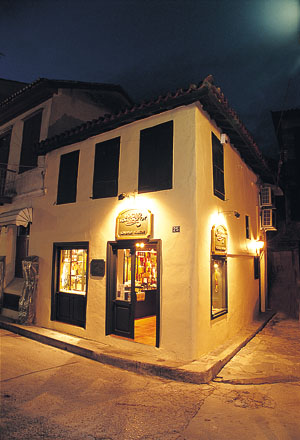 In April 1998 founded in Nafplion the first – and only in the world – Museum of Rosary by Evangelinou couple, who collect and study the rosary since 1958. In Alexandria, Egypt, where the grandfather of Mr. Evangelinos lived, they took their first lessons and learned the “secrets” of the rosary.
In April 1998 founded in Nafplion the first – and only in the world – Museum of Rosary by Evangelinou couple, who collect and study the rosary since 1958. In Alexandria, Egypt, where the grandfather of Mr. Evangelinos lived, they took their first lessons and learned the “secrets” of the rosary.
Since 1963, they started the long journey to the streets of the rosary, which still continues. They collect knowledge and rare old rosaries from around the world -Hinduists’, Buddhists’, Muslims’, Catholics’ and Greeks’- the countries that Greek Culture prospered (Asia Minor, Syria, Egypt etc.).
Thus, they acquired a unique collection in the world with around one thousand (1000) rosaries, dating from 1700 to 1950, made of pure amber, amber-mastic, amber-fatouran, black (giousouri) and red coral, ivory, bone, horn, ebony etc.
The Museum houses the collection of rosaries with a historical path of 4 small rooms:
In room A: Hindus, Buddhists, Muslims
In room B: Rosaria Catholic monasteries and prayer by
In the halls C and D: Greek
From its inception until today, the Museum has hosted more than 75000 visitors.
The purpose and mission of the museum is to preserve and disseminate traditional Greek rosaries…
The museum is housed in two storey building in the old city of Nafplio, on the street Staikopoulou 25.
The showroom is located on the upper floor. The ground floor is the workshop of the Museum, which preserves the old rosaries and builds replicas of the old handmade rosaries made in privately owned workshops in the East. The workshop maintains the old relic-rosaries by family donations.
The ground floor is, also, the shop of the Museum, selling the output of the workshop. The Museum operates under the Ministry of Culture.
Museum Hours: Monday-Sunday: 09:30 – 20:30 (closed on Tuesdays).
Distillery Museum
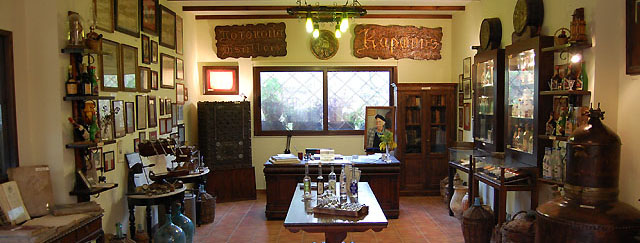 Shortly after the establishment of the official Greek nation in 1840, Giannis Karonis opens and maintains ouzo shop in Nafplion.
Shortly after the establishment of the official Greek nation in 1840, Giannis Karonis opens and maintains ouzo shop in Nafplion.
After several stages, and given his love for the production of ouzo is equipped with two stills and luxuriate in the secrets of distillation.
The project gets flesh and bones in 1869, when officially founded the distillery Karonis.
Pioneers, as were the Karonis brothers set up a production unit of alcohol, using stills and machinery from France and Germany in a modern factory for the era.
Craftsmen from Italy install stills and a series of built tanks. Alcohol was used for the distillation and production of ouzo and mastic. Then the company designation “pnevmatopiio” (distillery) the Tegea. The production is growing and distribution of products go beyond the city limits, which are transferred to the surrounding areas by boat and by train. In 1947 the company acquired its first truck, expanding the distribution network. The recognition was not long before the first discrimination in a fair in Zappeion, Athens – 1889. Gold and silver medals follow, in the International Fair of Thessaloniki, which seals the quality of the distillate.
The persistence of G. Karonis achieve the best quality results in the use of better varieties of anise and other herbs, giving the next 4 generations the precious recipe of ouzo Karonis which remains unchanged until today. The distillery museum you can see tools, equipment, documents of the distillery dating from 1880 and onwards. See the first evaporator of the distillery and its purchase invoice from France … and much more. For group visits please contact us on +30 27520 24968 for better service. Tours in English, German, French, Italian, Spanish are also possible.
Open hours: 09.00 -15.00 and 17.00-20.00. Excluding holidays: 1st, 2nd, 6th January, Shrove Monday, Good Friday, Easter Sunday, 1st May, Aghiou Pneumatos, 28th October.
Automotive Museum
The Museum of Automotive of Nauplia is the result of many years of collecting passion and a dream come true through a collective and cultural effort and without profit.
Through the exhibition of historical vehicles, the Greek Federation of Age Vehicles (EOOE) wishes to highlight the cultural and industrial heritage. The vehicles are Greek and non-Greek manufacturing. Through observation of the evolution of vehicles in the museum, visitors can understand the technological progress of vehicles depending on the economic and social factors that influenced this evolution. The observation of such vehicles is not only educational, but stimulates the memories of everyone who visits the museum. Some because they lived together with the movement of a car, recognizing some of these vehicles from the films of old Greek and foreign cinema and some simply because they nourish love for old cars. In the large facilities of the exhibition of the Museum, visitors will have the opportunity to experience up close rare and preserved models that work flawlessly. Also, the museum is holding a special library of subject on the car with a rich addition of audiovisual material.
One of the activities of the Museum of Automotive of Nauplia is an annual event of the Regularity Rally for historic cars and motorcycles. A contest of elegance of the era vehicles «Concours d’Elegance» and a bazaar of parts for classic cars. More information about the museum can be found online at: www.automuseum.gr
Ecclesiastical Museum
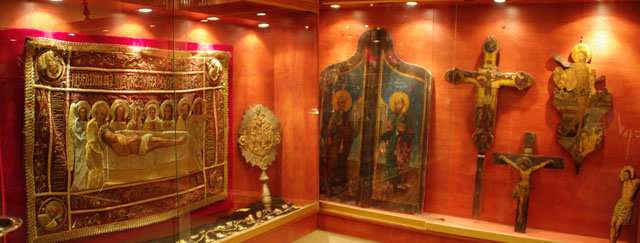 Το Εκκλησιαστικό Μουσείο του Ιερού Ναού «ΕΥΑΓΓΕΛΙΣΤΡΙΑΣ» Ναυπλίου, στεγάζει τη συλλογή εκκλησιαστικών αντικειμένων και βρίσκεται στην νότια πλευρά του Ιερού Ναού, σε αίθουσα,όπου μαζί με το παρεκκλήσιο του Αγίου Φανουρίου, αποτελεί ενιαίο χώρο και λειτουργεί ως Εκκλησιαστικό Μουσείο.
Το Εκκλησιαστικό Μουσείο του Ιερού Ναού «ΕΥΑΓΓΕΛΙΣΤΡΙΑΣ» Ναυπλίου, στεγάζει τη συλλογή εκκλησιαστικών αντικειμένων και βρίσκεται στην νότια πλευρά του Ιερού Ναού, σε αίθουσα,όπου μαζί με το παρεκκλήσιο του Αγίου Φανουρίου, αποτελεί ενιαίο χώρο και λειτουργεί ως Εκκλησιαστικό Μουσείο.
Ο κύριος όγκος των έργων χρονολογείται στο 18ο και 19ο αι.
Οι φορητές εικόνες αποτελούν τον πυρήνα της συλλογής του μουσείου και ταυτόχρονα το σπουδαιότερο και μεγαλύτερο τμήμα της και εκπροσωπούν κάθε κατηγορία.
Υπάρχουν εικόνες τέμπλου (δεσποτικές,θεομητορικές δωδεκαόρτου,Αγίων), προσκυνήσεως (προορισμένες για τον τοίχο ή για ιδιαίτερο προσκυνητάρι) και εικόνες διαφόρων μεγεθών για ιδιωτική λατρευτική χρήση. Η συλλογή περιλαμβάνει ακόμα, ένα ξυλόγλυπτο Σταυρό του 16 αι.
Όσον αφορά τον τομέα της αργυρογλυπτικής υπάρχει μια σειρά από επίχρυσα ιερά σκεύη, καντήλια, κτλ .
Στον τομέα της υφαντικής υπάρχουν ωραιότατα κεντητά με χρυσό,καλύμματα για δισκοπότηρα.
Επίσης υπάρχει συλλογή λειτουργικών βιβλίων (Ευαγγέλια ,Μηναία κ.α.) τα οποία τα περισσότερα έχουν τυπωθεί στην Βενετία σε γνωστά τυπογραφεία του 18ου αιώνα.
Από πλευράς θεματολογίας οι εικόνες καλύπτουν όλη την κλίμακα της ορθόδοξης δογματικής ιεραρχίας.
Υπάρχει σημαντική ποικιλία καθιερωμένων εικονιστικών τύπων του Χριστού, της Παναγίας, αλλά και πολλών Aγίων, που ανταποκρίνονται στο εορτολόγιο και αγιολόγιο της Εκκλησίας, αλλά και στις ανάγκες για προσκύνηση και λειτουργική χρήση. Ενδιαφέρον παρουσιάζουν οι αφιερωματικές επιγραφές με τα ονόματα των αφιερωτών και των χορηγών.
Το Εκκλησιαστικό μουσείο τελεί υπό την άμεση εποπτεία του Ιερού Ναού «ΕΥΑΓΓΕΛΙΣΤΡΙΑΣ».
Τα εκθέματα καλύπτουν το χρονικό διάστημα από τον 16ο έως τον 20ο αι. και αποτελούν μάρτυρες της μεταβυζαντινής εκκλησιαστικής τέχνης της περιοχής.
Σκοπός του μουσείου είναι η περισυλλογή, διαφύλαξη, συντήρηση, έκθεση και προβολή των πάσης φύσης αντικειμένων που προβάλλουν την εκκλησιαστική τέχνη του ιερού Ναού.
Ωράριο λειτουργίας μουσείου: Κατόπιν συνεννόησης
Για να κανονίσετε την ιδιωτική σας επίσκεψη θα χρειαστεί να κλείσετε προηγουμένως συγκεκριμένη ημερομηνία και ώρα μέσω τηλεφώνου στο 27520 27778.
πηγή: nafplio.gr



